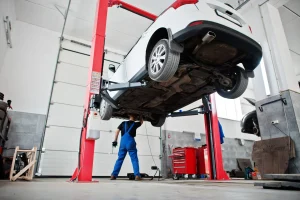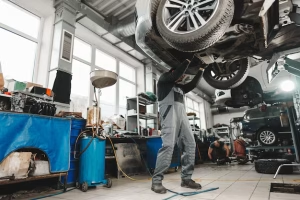Owning a car means independence, convenience—and occasionally, maintenance surprises. While routine servicing can help keep your car running smoothly, unexpected issues on the road happen to everyone. That’s why every driver should have a basic toolkit of DIY car repair skills to turn those “uh-oh” moments into manageable tasks.
Whether you’re a busy professional, a car enthusiast, or someone looking to save money and reduce your environmental impact, these 10 essential DIY repair tips will help you maintain your vehicle like a pro.
Let’s get your hands dirty (but your wallet not so much).
1. Changing a Flat Tire
A flat tire can bring your plans to a screeching halt—literally. Knowing how to change your tire quickly and efficiently is an essential skill every driver should master.
Steps to Change a Flat Tire:
- Pull over to a safe location and turn on your hazard lights.
- Use your car’s jack to lift the vehicle until the flat tire is off the ground.
- Loosen the lug nuts with the wrench, remove the flat tire, and replace it with the spare.
- Hand-tighten the lug nuts, lower the car, and then tighten them securely with the wrench.
Pro Tip: Always keep your spare tire properly inflated and check for the jack and lug wrench in your trunk before heading out.
2. Changing the Oil
Oil changes are crucial for keeping your engine running smoothly. Skipping this task can lead to expensive engine repairs later.
How to Change the Oil:
- Park your car on a flat surface and wait until the engine cools.
- Locate and unscrew the oil drain plug, allowing the old oil to drain into a pan.
- Replace the drain plug and remove the old oil filter.
- Install a new filter, then refill the engine with the recommended oil type.
Pro Tip: Schedule your oil change every 3,000 to 5,000 miles (or follow your car manufacturer’s specifications).
3. Replacing Windshield Wipers
Driving with squeaky, streaky wipers during a downpour? That’s a recipe for disaster. Changing your windshield wipers is quick and easy.
How to Replace Your Wipers:
- Lift the wiper arm away from the windshield.
- Press the release tab on the old wipers and slide them off.
- Align the new wipers with the arm and snap them into place.
Pro Tip: Replace wipers annually or whenever they begin to leave streaks.
4. Replacing Air Filters
Your car’s air filter impacts fuel efficiency and engine performance. Clean air filters are essential.
Steps to Replace an Air Filter:
- Open the hood and locate the filter housing (usually a black plastic box).
- Remove the clips or screws to access the filter.
- Take out the old air filter, insert the new one, and secure the housing back in place.
Pro Tip: Replace air filters every 12,000 to 15,000 miles.
5. Jump-Starting a Car
A dead battery can be frustrating, but jump-starting a car is easier than you think.
How to Jump-Start Your Vehicle:
- Park both cars (yours and the helper’s) nose-to-nose.
- Connect the jumper cables in this order: red to the positive terminal of the dead battery, red to the positive terminal of the charged battery, black to the negative terminal of the charged battery, and black to an unpainted metal surface on the stalled car.
- Start the vehicle with the good battery, then attempt to start your car.
Pro Tip: Remove the cables in reverse order after jump-starting.
6. Checking and Topping Up Fluids
Fluids keep your car in peak condition, from brake fluid to coolant. Skipping a fluid check can spell trouble.
DIY Fluid Check:
- Check oil, coolant, brake fluid, power steering fluid, and windshield washer fluid levels using their respective caps and dipsticks.
- If levels are low, top them up using the specified type of fluid.
Pro Tip: Never open the coolant cap when the engine is hot—it can lead to burns!
7. Changing Spark Plugs
Faulty spark plugs can lead to poor gas mileage and engine misfires.
Steps to Replace Spark Plugs:
- Locate the spark plugs (check your owner’s manual if unsure).
- Remove the old spark plugs using a spark plug socket.
- Insert and tighten new plugs to the manufacturer’s recommended torque.
Pro Tip: Replace spark plugs every 30,000 miles for optimal performance.
8. Replacing the Battery
If your car struggles to start, it may be time for a new battery.
How to Replace a Car Battery:
- Disconnect the negative terminal first, followed by the positive.
- Remove the old battery and place the new one in the same orientation.
- Secure the battery and connect the terminals, starting with the positive first.
Pro Tip: Clean the terminal connections with baking soda and water for better conductivity.
9. Handling Overheating
An overheating engine can cause panic, but knowing what to do can prevent damage.
Steps to Handle an Overheating Car:
- Turn off the air conditioning and turn on the heater to wick heat away from the engine.
- Pull over and allow the engine to cool before opening the hood.
- Check the coolant level and top it off as needed.
Pro Tip: Regularly check coolant levels to avoid overheating issues altogether.
10. Troubleshooting the Check Engine Light
The check engine light can be alarming, but it’s not always an emergency.
Diagnose the Problem:
- Use an OBD2 scanner to read engine codes from your vehicle.
- Look up the code in your owner’s manual to determine what repair is needed.
Pro Tip: Many auto parts stores offer free OBD2 scans if you don’t own a scanner.
Drive Smarter, Not Harder
Being equipped with these 10 essential DIY car repair tips can save you time, money, and peace of mind. Whether you’re replacing a battery or jump-starting your car, taking care of minor car issues on your own lets you stay in control.
The more you practice these skills, the more confident you’ll become as a car owner. And remember, sharing tips among fellow drivers helps us all stay safer on the road.
Got a favorite tip of your own or a DIY car repair story to share? Drop it in the comments below—we’d love to hear from you!
Happy driving and happy repairing!


